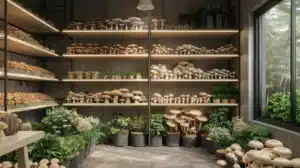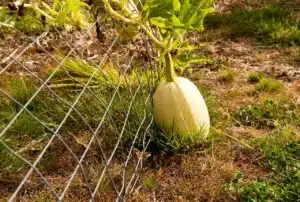
How to Grow Mushrooms
How to Grow Mushrooms – A Complete Guide for Cultivating Mushrooms in Your Home Growing mushrooms can be a rewarding and satisfying experience. If you are
This awesome clock took me only 4 evenings to complete. I suspect that I could have made it much quicker if I wasn’t power tool challenged! The great thing about this faux cuckoo clock is that you do not need to use power tools to build it. Of course, if you are someone who is comfortable using powers tools – go for it! Get the details on how to make your own DIY SimpleLine Cuckoo Clock knockoff.
Before I could start building, I had to gather the supplies. This turned out to be more challenging than putting the clock together. The original clock has a Black Forest weighted cuckoo clock movement. I am no clock master, and even though I found traditional weighted cuckoo clock movements online, they were expensive and I knew I wasn’t talented enough to actually use one of them. I opted for the much safer/easier quartz movement.
Table of Contents
ToggleI did find a quartz cuckoo clock movement that would cuckoo on the hour which came with little plastic weights, chain and a pendulum for under $20.00. However, I did not like the look of the little plastic pine cone weights and the pendulum was pretty short. I think the chain was probably plastic as well. But this might be a good option to at least get the cuckoo clock sound by using just the clock movement piece.
We have a cuckoo clock already, but we do not have a Westminster chiming clock. The Westminster clock movement with pendulum was just under $50. This was more than I wanted to spend on a project I wasn’t sure would turn out. Eventually, I will replace the movement in my clock with the Westminster chime movement.
In the end, I ordered a clock movement with a pendulum for just under $15.00 online. I saw a similar one at Hobby Lobby for $27.00. My clock will not chime or cuckoo unless I change out the clock movement, which I will eventually do because I do love this clock!
My next issue was to find something to use for the clock weights. I searched for weights like the ones on the SimpleLine clock, but could not find any. I was determined not to use the standard pine cone weights, so I started looking around for a substitute. The other issue was that my clock would be constructed out of a lighter weight material, so I couldn’t use actual weights anyway, I needed something lighter that would give me a similar look. On eBay, I found these awesome goat bells and knew I had found what I was looking for!
I ordered a set of 4 bells for $11.00 which included the shipping. A friend of mine wanted two of them for a project she was working on, so we split the cost so I had 2 bells for $5.50. These bells measure 3-3/4″. Perfect for this project.
My next decision was what to use for the cuckoo bird. I decided to make my own bird out of oven bake clay.
The clock itself was made with two sheets of thin ply wood and a sheet of balsa wood that I picked up at my local Hobby Lobby. For the weight chains, I used an old necklace chain that I had from a previous project.
I know that I could have probably gotten the wood cheaper at the hardware store, but my idea was to try to use materials that found from a craft store. Easier for me than navigating the hardware store.
2 sheets of ply wood – the label says 3/32x8x24 – $7.99 each
1 Sheet of balsa wood – the label says 3/16x6x36 and was $6.99
1 package of Sculpey oven bake clay in Deep Red Pearl – $2.27
1 quartz clock movement with pendulum $15.00
2 goat bells $5.50
White Spray Paint
Black Spray Paint
Clear coat Spray Paint
White craft paint
Black Craft Paint
Super glue
metal ruler
pencil
box knife with sharp blade
sand paper
Patch – n – Paint lightweight spackling
length of chain
optional: small piece of embossing foil
scissors
paint brush
drill bit
Square of Styrofoam
E6000 glue
painters tape
right angle square
toilet paper roll
I chose to use the thin plywood and balsa wood because it can be cut easily using a box knife or an exacto knife with a new sharp blade. By using this material, I was able to make this clock without using a single power tool!
Now you may be thinking that thin plywood and balsa wood does not a sturdy clock make. This could be true. However, I consulted with Mr. Hobby who gave me the information I needed to make sure that my clock construction would be very solid and my joints would be strong.
First thing I did was to draw a pattern of the front clock face directly on a piece of plywood using a pencil and a ruler.
I figured where I wanted the hole for the cuckoo bird and where I wanted the clock hands and marked them as well.
My clock face is 5 inches wide, 16 1/2 inches from the tip of the peak to the bottom. The peak slant ends 3 inches down from the peak center. I just eyeballed the hole for the cuckoo bird and it ended up starting around 4-1-2 inches down from the peak. The small hole for the clock movement was placed in the center 4-1/2 inches from the bottom. I measured 4-1/2 inches from the bottom and found the center and marked the hole for the shaft of the clock movement with an x at this point.
After I was satisfied with the dimensions, I put the plywood on top of an old piece of plywood to protect my counter while I was cutting (yes, I made this on my kitchen counter). Using a metal ruler as a guide, I scored each line with the box knife using light pressure. Then I went over each scored line several times using medium pressure until I cut through the wood. It cut pretty easily. It is easier to control the knife when using light pressure, so the first scored line was always done this way. The knife blade should easily follow the scored line on the additional passes.
The key here is to take your time, hold your ruler steady and only use light pressure for the initial scoring so that you get a nice straight line.
I used the face panel I just made as a pattern for the back panel and drew the outline on the 2nd sheet of plywood and cut it out using the same process outlined above.
The side panels of the clock are 3 inches wide. These were easily cut because the plywood sheet I had was 8 inches wide. So the leftover material after cutting out the front and back panels was already 3 inches wide. I just had to cut it to length. Using the clock face as a pattern, I made the cut for the length where the roof peak started on my front panel. I cut using the same scoring process outlined above.
It is next to impossible to cut identical pieces by hand, but they were very close. To get them to be identical, I took a couple of pieces of painters tape and taped the front and back panels together and the side panels together. Using a fine grit sand paper on a sanding block, I quickly sanded the each side of the pieces so that they were identical. This just took a few minutes because my pieces were pretty close. The sanding block just makes the sanding process easier, but this could have been done without the block.
To cut the circle for the cuckoo bird to sit in, I again used the box knife. I carefully scored the wood in a grid pattern until I cut through the material. I got close to the edge of the circle, but not quite to the pencil line. By the way, I traced the circle using a circle stencil. You could use any flat round object to trace the circle – mine is a little larger than a milk carton cap.
I used sandpaper to remove the material left and to get a nice smooth clean edge.
For the clock face, I wasn’t sure how I would be able to cut out a small circle for the clock movement to fit through. Mr. Hobby solved that problem for me by taking a drill bit that was slightly larger than my clock shaft and he just hand drilled a hole using light pressure and rotating the drill bit around until the hole was cut. I repeated this process on the back panel 3 inches down from the peak in the center so that I would have a hole to hang the clock. I used the sand paper to clean up the edges where the holes were made.
On the back panel, I cut out a rectangle area using the box knife and scoring method. This would be used to access the clock movement and change the battery. I sanded the edges smooth.
The roof pieces were cut from the left over plywood. The roof pieces sit flush at the back of the clock, but overhang the front of the clock. My pieces ended up being 4 inches wide and 8 inches long. If I made this clock again, I would probably shorten the roof pieces by an inch because I think mine were slightly longer than they should have been. Two pieces were cut, taped together and sanded to make them identical.
Because of the working pendulum, faux bell weights and chains, I knew that I needed the pendulum to sit back further than the chains so that they would not bump into each other. In order to accomplish this, I made sure that the clock movement that I purchased had a long shaft. The quartz movement that I bought had a clock shaft of just under an inch from the tip to the base of the movement box. This is important in order to have the space needed to have the pendulum swing freely. The longer the better – depending on what you use for weights.
I had to come up with a way to set the clock movement back without adding too much weight to the clock. I found the solution by cutting a piece of Styrofoam to sit between the front panel and the clock movement. Alternatively, I could have built up some balsa wood by cutting pieces and gluing them together to the correct thickness and then drilling a hole for the clock shaft to fit through. Typically a block of wood would be used, but this is a lightweight clock and so lightweight alternatives were necessary.
This picture shows the cut Styrofoam piece that I poked a hole through for the clock shaft to fit through. I had to make sure that my Styrofoam piece also allowed enough of the clock shaft to fit through the front panel of the clock so that I could attach the clock hands.
With that issue solved, I was ready to glue my clock together.
Luckily, Mr. Hobby saw I was getting close to the glue stage and he suggested that I cut strips of balsa wood to glue onto the back side of the front and back panels so that I would have more ‘surface area’ to glue to. This would make the clock more sturdy and stable and help to keep the clock as square as possible. This sounded a little tricky to me, but it was actually very easy.
Using his suggestion, I cut 4 thin strips of balsa a little shorter than the area I wanted to glue. These strips were about a quarter-inch wide. I cut them using the ruler to get a straight line cut and cut them very easily using the box knife. I laid the front panel – front side down and then using a side panel as a guide, I lined up the pieces as if they were already glued. I then took one of the balsa strips and set it in place and tacked it down with a few drops of super glue to hold it in place. This is a little tricky, but the idea is to just tack down the balsa once you have it in place then remove the side panel and run a bead of super glue down the length of the balsa to secure it.
I attached 2 balsa strips to the back side of the front and rear panels. I let that dry for 10 minutes and then I glued the side panels to the front panel. I used a right angle square to keep the side as square as possible. If you don’t have one of these, use a box to hold the side panel in place to keep it square while gluing. I used standard super glue and ran a bead of glue on the back panel and on the side of the balsa.
Before gluing the back piece on, I used E6000 glue to glue the Styrofoam square in place. This glue takes a little time to set up. I also put a few drops of the same glue on the clock movement to attach it to the Styrofoam to hold it in place. I set something heavy on it and let that glue dry overnight.
The next day I was ready to glue on the back panel and it slid nicely into place.
I lightly sanded down the goat bells and spray painted them with two coats of black spray paint and one coat of a clear top coat. I also spray painted the brass pendulum with two coats of white spray paint and one coat of a clear top coat. Just make sure you allow your spray painted pieces to completely dry before adding the next coat.
For the bottom piece of the clock I used the balsa wood. I set the clock upright on the balsa and I traced a foot print of the bottom of the clock. I cut that out and then just trimmed it slightly using a ruler as a guide to keep a straight edge. I trimmed with the knife box blade until I had a snug fit. I duplicated the process so that I had two pieces of balsa that were the same size. I just eyeballed where the pendulum would swing and cut a hole for the pendulum.
Using a pencil I also cut out two holes for the chain to fit through toward where the front of the clock was. Then I used super glue and glued the two balsa pieces together. To help support the weight of the chain and bells, I added one more strip of balsa, with holes for the chain, to the front of the base.
Before I glued the base in, I made sure that the chains fit, and I attached the pendulum to the movement and made sure that the hole I cut was sufficient for the pendulum to swing. When everything tested out – I glued in the bottom piece that I made using super glue.
I pulled out the molding clay and made a little bird. Took me all of 3 minutes to make. I put it in the oven according to the package instructions and wa la – a cute little red cuckoo!
I took an empty toilet paper roll and cut off an 1-1/2″ piece. I spray painted the inside black, along with a piece of cardboard to glue to one end to seal it. I super glued this behind the cuckoo hole to make the cuckoo bird house.
It was time to attach the roof. I had cut the roof pieces from the thin plywood. They really needed to be thicker – so I cut 2 additional roof pieces out of the thicker balsa and I glued them together. Again I added balsa strips so that I had more gluing surface to attach my pieces to.
Before I painted, I filled in any gaps from the glued edges with spackling. I allowed that to dry for an hour and then I lightly sanded the edges smooth.
It was time to paint. In hindsight, I probably should have painted the house and the roof pieces before they were attached – but I had already glued everything together before I thought of that.
Anyway, it painted up very easily with two coats of white craft paint on the clock box and 2 coats of black craft paint on the roof. After it dried, I sprayed the entire house with a clear finish coat.
The last problem I had was the clock hands. The hands that came with the clock movement I bought were more traditional than the modern look I was going for and they were really too long for my clock. To solve the problem, I took a pair of scissors and cut off the tip of each clock hand to shorten them. I could have used them like this, but it was just not the look I wanted. So I cut a strip of metal tooling foil in the shape I wanted and glue them to the hands, then spray painted them black. I could have shopped online and found different clock hands, but I figured I would try to work with what I had and it worked perfectly.
I also spray painted the little clock hand attachment pieces with silver spray paint as they were all brass. When they were dry, I attached the hands, faux bell weights, pendulum, added a battery and hung it on the wall. The clock has kept perfect time and I love the look of it!
The clock is lightweight, yet very sturdy thanks to the added balsa wall supports. And after all the planning and issues were solved – it was pretty easy too!
I hope you find this tutorial helpful. If you decide to make one of these for yourself, I’d love to see it!

How to Grow Mushrooms – A Complete Guide for Cultivating Mushrooms in Your Home Growing mushrooms can be a rewarding and satisfying experience. If you are

The Complete Guide to Growing Spaghetti Squash: From Seed to Harvest Spaghetti squash is a nutritious and delicious winter squash that’s growing in popularity, particularly

Cauliflower Growing Guide: Comprehensive Guide for Success Cauliflower can be used to elevate any dish. It is highly nutritious, versatile and delicious. Cauliflower can be used

The Joy and Pain of Growing Citrus Indoors I’ve often been asked about growing citrus indoors or how to cultivate citrus in containers, and while

How to Grow Zaluzianskya Capensis, Night Phlox I can still remember the first time I came across the name Zaluzianskya trying to pronounce it silently

Grow Your Own Dill: A Complete Guide to Cultivating this Aromatic Herb at Home If there’s one herb that perfectly balances aromatic and tangy flavors,